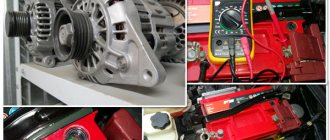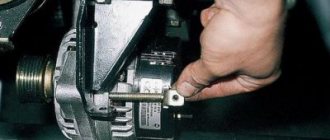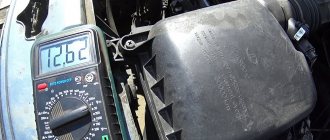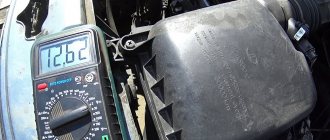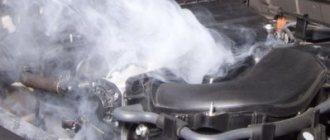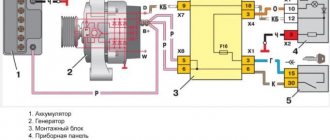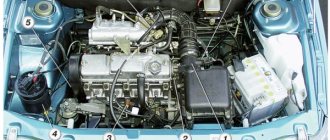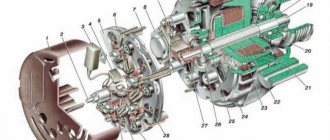Causes of generator overheating
Why does the generator on the car heat up to such an extent that it is impossible to touch it? The charge is normal, no visible problems were noticed. As a rule, the gene heats up within twenty minutes of operation. What is the reason?
Is it normal for a new generator to heat up to 90-100 degrees or not? Yes, if you drive many kilometers without stopping, you won’t be able to touch the engine or other components under the hood, they will be so hot. The generating device produces currents in the region of 100-110 amperes. With such voltage and the relatively small dimensions of the power plant, as well as the lack of proper cooling, overheating is justified.
However, strong heating after 15-20 minutes with a relatively cold engine is not the norm. It is clear that it is caused by excessive loads, and if the smell of burning is added, then the problem is obvious.
It is noteworthy that many people note a characteristic buzzing sound.
Theory of the issue
While the car is moving, a dead battery receives a charge voltage of 13.6 to 14.2 V. For the correct and stable operation of all systems in the car, these voltages must be maintained until the engine starts and the crankshaft rotates. Together with the motor, torque is supplied to the generator through the drive belt. At this moment, an amount of energy is generated that will be sufficient for the stable functioning of all systems and to maintain a charge on the battery.
If the generator does not charge, then in most cases the reasons must be sought in the excitation circuits, as well as in the output voltage circuits from the generator to the battery. But this is not always the case. Sometimes problems are related to the generator itself.
When the driver turns the key in the lock, the relay in the ignition system also starts at the same time. “Plus” flows through the relay and fuse in the mounting block. Next, the voltage passes through the on-board network, reaching the battery charge lamp and charge sensors. It then passes through diodes, relays, elements in the mounting block and finally to the connector in the generator. There, electricity comes to the relay-regulator and, passing through brushes and slip rings, enters the exciting winding.
Why does the generator wire get hot?
Another common problem is heating of the wires coming from the generator. This problem can be dealt with very simply, since the cause will be a faulty electrical wiring.
Checking the generator wiring with a multimeter
Take the Ts-shka and ring all the wires. When you find a faulty one, simply replace it.
How to determine that the generator is not charging the battery
The easiest way to check that the generator is not charging (VAZ-2110 is no exception) is by looking at the dashboard. There is a control lamp on it. Classic VAZ models also have a voltmeter. The arrow should be in the green zone, and the control lamp should be in normal mode (when everything is in order, it does not light up). If this is not the case, then charging does not occur. It is worth considering the problem in detail.
Normal or not normal?
The generator inevitably heats up during operation, so first of all, let’s figure out what kind of heating can be considered normal. For example, if you have driven a long way without stopping. In this case, even the new and most modern generator will overheat to 90-100 degrees. This is normal, because the device produces currents at the level of 100-110 amperes.
It’s a completely different story if such heating is achieved after 15-20 minutes of travel, when the engine has not yet had time to heat up. Heating is often accompanied by a burning smell or a specific buzzing sound. These are already reasons to be wary.
Generator overload
If the battery is charging, but the voltage is insufficient, it means the generator is overloaded. This is facilitated by the installation and connection, in addition to standard electrical equipment, of various gadgets that require electricity. The generator is operating at the limit of its capabilities.
Modern drivers love various car tunings. Thus, serious music systems, powerful lighting and other equipment are installed. Someone also increases the battery power. So, with a 70 Ah battery, the standard VAZ generator cannot fully charge it. It just doesn't have enough power. As a result, the generator provides little charge.
Thermostat failure
If the thermostat valve is stuck in the closed position, the coolant will circulate in a small circle, thereby the engine will overheat very quickly. To solve this problem, you need to replace the thermostat with a new one.
If suddenly this problem turns out to be on the way, and you need to travel quite a distance to the repair site, then you can try knocking on the thermostat housing, perhaps this will lead to its normal, albeit temporary, functioning.
Short circuit to the rotor housing
In the event of this malfunction, the entire field winding will be closed and the generator will not be able to operate. Often, short circuits to the frame occur in places where the ends of the winding are connected to the slip rings on the rotor. You can check this using a 5 V lamp. To check, the wire should be connected to one of the slip rings, and the second to the rotor core or its shaft. In the event of a short circuit, the lamp will light up. This generator is faulty. You can insulate the short circuit or replace the winding completely.
Diode bridge
Excessive heating of the generating device will certainly lead to further problems. Heating occurs for various reasons, but most often the diodes in the unit burn out.
Generator diode bridge
In general, checking the diode bridge in such cases is a must. It happens that after overhauling the generating device or replacing machine components, the car service center forgets to put gaskets on. For example, under the rectifier unit itself. Because of this, the device begins to get very hot, as it short-circuits to the case without protection (gasket).
It could also be this: the soldering on the diode bridge is relaxing. The reason will only be revealed by opening the GU (generator). There may be unsoldered contacts or so-called “dry” soldering. It is possible that the terminals are not tightened or the rectifier unit is broken.
Algorithm for finding the cause
We looked at typical faults. But it is important to find the main reason. If the car has standard equipment and there are no abnormal energy consumers, then you can begin to diagnose the generator directly. If there are additional consumers, it is better to turn them off. In this case, it must be disconnected physically, from the on-board network.
Next, all consumers are connected and the leakage is measured in the same way with a multimeter. If it is large, then the reason should be sought not in the generator or battery, but in one of the devices in the on-board network. If no leakage currents are detected at rest, then most likely the VAZ generator is not charging. We have already discussed the reasons.
Why does the generator pulley get hot?
The generator pulley on a VAZ car gets hot: in this case, there can be a lot of problems, here are the main ones:
- I overtightened the belts and this caused the bearing to get hot.
- The belts are not tightened enough, they slip and heat the pulley by friction.
- Interturn.
- Short circuit in the power circuits, the rectifier may be faulty.
In any case, even if the generating device is new, disassemble it and check for the above faults.
Design of a car generator
Any generator, with the exception of direct current models, creates multiphase alternating current - three or four phases, depending on the power. Why such a complication if the on-board network uses only direct current anyway? The fact is that a multiphase alternating current generator has higher efficiency, and most importantly, the current is removed not by brushes from the rotating rotor, but from the stationary stator windings. Accordingly, there are no problems with burnout of the collector (the current in it is much less than what the generator produces), and the collector itself is simpler - two rings, and not a set of insulated lamellas.
Wiring
When it comes to overheating in the power supply system, why not pay attention to the wiring. In this case, it is recommended to test the entire positive cable laid from the battery to the power unit. It is possible that there is not enough insulation somewhere and there is a short circuit.
Generator bearing
There should be a fuse on the wiring going from the battery to the main unit. When a diode bridge breakdown or other short circuit occurs, the fuse fails, not the positive wire. This option is available on some domestic models (for example, GAZ).
Possible causes of malfunctions
Brush wear
If the generator does not charge the battery, then the first thing that comes to mind on cars with sufficient mileage is wear of the brushes. There are few purely mechanical components in generators that affect its performance - and the brushes, constantly rubbing against the commutator, are worn out.
As the contact wears out, the contact deteriorates, and the current in the rotor winding drops accordingly. At first, the generator gives little charge at low speeds, “waking up” after re-gasping, then it fails completely. The brushes themselves can be either a separate unit or interlocked with a relay regulator.
When removing the brush assembly from the generator, you can easily feel how far it can be extended so that the elasticity of the springs is no longer felt - this will be the remaining working length of the longest brush. Please note that more often the brushes wear unevenly: on the side of the cover, where dirt and brush wear products accumulate, the brush wears out faster. This is also noticeable by the presence of a groove on one of the rings.
The groove itself is not so bad if it is worn evenly. Here it is wavy, with sharp changes in diameter - a direct indication of replacing the slip rings or rotor assembly. On foreign generators there is a monoblock design, when the diode bridge, the relay-regulator, and the brush assembly are one whole. Replacing such a monoblock is not a cheap matter, and it is stupid to do it when only the brushes are worn out. Therefore, they are soldered, selecting suitable ones from domestic generators or power tools.
Break
In the rotor, in addition to wear of the slip rings, there are few probable causes of malfunction - relatively low currents do not allow the winding to burn out, and much more often the wire breaks at the junction with the collector. The rotor is checked with a tester: first, the resistance between the collector rings is measured, then between the rings and the “ground”. In the first case, the resistance is several ohms, in the second - “infinite” (there is no short circuit of the winding to the housing).
Stator and diode bridge
Another reason why the generator does not charge is the most loaded components: the stator and diode bridge. With constant overloads, they overheat, which for the stator is fraught with destruction of the insulation, short circuit to the housing and fire of the winding, and for the diode bridge - failure or breakdown of the diodes. Externally, the symptoms are similar - the power of the generator drops (one or two phases do not work), or the generator fails completely.
battery
In any case, the car owner should look for the reason for the high voltage consumption. That's what the experts and electricians say. And the first thing they do is diagnose the battery.
As you know, during engine operation, the PG must provide a charge to the battery. If cans or something else fly off the battery, then the current flow process will be continuous and in large quantities, which will a priori cause the device to overheat.
| Cause | Solution | |
| Battery | High voltage consumption due to excessive current output, oxidation, short circuit and failure of cans | Replace battery, charge |
| Diode bridge | Lack of gasket, loose soldering, loose terminals, breakdown | Overhaul, replacement, repair |
| Bearings | Failure of the front, rear or both together | Replacement of wiring, new insulation |
| Wiring | Insufficient insulation, short circuit | Replacement of wiring, new insulation |
News:
- Chevy-Clan.RU »
- Technical Section »
- TechSection »
- Square – Chevrolet Blazer / GMC Jimmy »
- Optics. Headlights (Moderators: Akulych, Daria, i-man) »
- The generator is heating up.
Author Topic: The generator is heating up. (Read 19073 times)
0 Users and 1 Guest are viewing this topic.
- Chevy-Clan.RU »
- Technical Section »
- TechSection »
- Square – Chevrolet Blazer / GMC Jimmy »
- Optics. Headlights (Moderators: Akulych, Daria, i-man) »
- The generator is heating up.
The page was generated in 0.323 seconds. Requests: 56.
- List of forumsDiagnostics and repair of MitsubishiDiagnostics and repair of Mitsubishi
- Search
Important Tips
The problem with a car generator is one of the most common. And why should we be surprised? The operating conditions of the generator cannot initially be called favorable. During active use, the device gets exposed to oil, dirt, salt and various substances that have harmful effects. Their effect is aggravated by high temperatures occurring in the engine compartment.
READ UK car production falls 14%, worst February in a decade
Attention. Experts insist - keep the clamps of all wires of the generating device under a layer of grease. Thus, it will be possible to minimize the oxidation of the terminals at the terminals of the generating device.
It is also recommended to pay special attention to timely renewal of the gene belt and its tension. It is prohibited to operate a power unit with a non-functioning or disconnected battery.
Note. For example, if you leave the gene running without a connected battery, this will cause a voltage surge in the vehicle’s on-board network, which is already dangerous for various electrical devices, including the generator itself.
If the problem of generator overheating is associated with the diode bridge, then the failure of the latter is caused by just such a situation or incorrect diagnosis of the power unit.
Often, inexperienced motorists, when checking the generating device, connect the output terminal to the car body. Such a “spark” test leads to a problem, since too high a voltage flows through the diode bridge, which can damage the elements of the unit.
All automobile generating devices are united by their structural similarity. Regardless of the GI models, they are all susceptible to the same “diseases”, and, accordingly, methods for their “treatment”.
One of the most common problems with GU, along with increased noise and lack of charge, is its rapid heating.
It is worth a lot to be able to diagnose GI on your own. You should learn how to at least carry out initial diagnostics that would confirm the malfunction of the power unit.
Here is how it is recommended to check the device:
- Open the hood of the car;
- First of all, start checking the alternator belt.
The belt is checked for integrity and tension. If the material shows signs of wear, large cracks and fraying, then this is a reason for replacement. A bad belt puts extra stress on the generator and other vehicle systems. Excessive load on the generator means overheating and rapid failure of the unit.
As for tension, the situation is similar here. A weak or over-tightened belt will negatively affect the operation of the generator.
The second in line after the belt is the fuse located in the block. As a rule, it is provided by the car manufacturer.
Next, check for oxidation of the battery terminals and the wiring going to the power unit. It would be a good idea to check the connector of the generating device.
The methods described above will help determine whether the electrical connection of the unit is in order and whether the belt is intact. However, checking the device does not end there.
- Turn on the ignition;
- Carefully monitor the battery charging indicator on the dashboard after starting the engine.
In general, if the indicator does not work when the ignition is on (half a turn of the key), then the battery may be dead, the indicator light itself may be damaged, or the wiring may be damaged. This may also indicate problems with the gene: failure of the tablet (voltage regulator), break in the winding or wear of the brushes.
If the indicator continues to light after starting the engine, then this also indicates a problem - one or more diodes of the generating device have failed, there is a short circuit in the circuit, the pulley is faulty, etc. The indicator light should not light up, since after starting, supplying consumers with current is entrusted not to the battery, but to the generator . A glowing indicator indicates that the battery continues to power electrical appliances.
If the indicator stops lighting only after increasing engine speed, the problem is low belt tension, worn brushes or a malfunction of the stator winding.
Further checking of the generator already implies a more detailed and professional examination. In particular, you should arm yourself with a special measuring device: a voltmeter or ohmmeter.
- The voltage is removed from the battery terminals and from the wiring going to the control unit. More than 14 volts is the standard voltage without electrical loads, 13.6 volts if optics and some other consumers are connected.
If the voltage does not exceed 12-13 volts, even after increasing engine speed to 1000 rpm, the power cable going to the power plant is in doubt.
If the readings are higher than normal, this indicates that the battery is overcharged, which a priori leads to battery failure.
Overheating of the generator is often associated with increased voltage on the vehicle's on-board network. This is usually caused by a faulty battery. A short circuit occurs inside the battery, one of the cans shorts out. This, accordingly, affects the operation of the generator.
Definitely, if the gene overheats, you should check the battery first. Often he simply sits down, for example, due to the operation of powerful acoustics. The lost supply of electrical energy requires replenishment, and what powers the battery while the engine is running is the generator. So it heats up in a short period of time if it delivers a voltage higher than it should be.
It wears out and, accordingly, the generating device heats up due to a faulty voltage regulator. A tablet or chocolate bar, as the regulator is commonly called, controls the voltage, preventing current from flowing in large quantities.
Being able to determine the cause of overheating is extremely important. In this way, it will be possible to prevent complete failure of the generating device and establish normal power supply in the network.
Sources:
https://avtoservis-68.ru/pochemu-greetsya-generator-na-avtomobile/ https://lk-transalyans.ru/pochemu-greetsya-generator-na-avtomobile/ https://ozapuske.ru/generator/ pochemu-greetsya-generator.html


